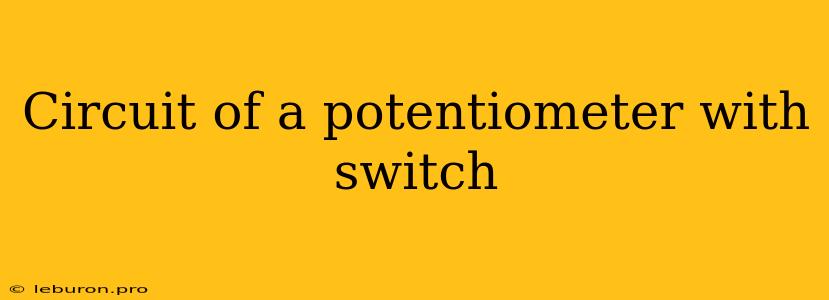A potentiometer, often referred to as a "pot," is a three-terminal variable resistor that allows for the adjustment of electrical resistance and, consequently, voltage. It is a fundamental component in countless electronic circuits, from volume controls in audio systems to sensor interfaces and voltage dividers. The operation of a potentiometer is predicated on the principle of sliding contact along a resistive element, thus changing the effective resistance between its terminals. This ability to adjust resistance and voltage makes potentiometers indispensable in a wide range of applications.
Understanding the Circuit of a Potentiometer with a Switch
A potentiometer circuit with a switch typically involves the potentiometer itself, a switch, and other external components depending on the specific application. The switch can be incorporated to enable or disable the potentiometer's functionality, or it can be used to select between different resistance values within the potentiometer's range.
Components of a Potentiometer Circuit
-
Potentiometer: The core component of the circuit, the potentiometer features a resistive element, a sliding contact (wiper), and three terminals.
- Resistive Element: This element, often made of carbon, cermet, or wire-wound, is the primary resistive component, providing the resistance path.
- Wiper: The sliding contact moves along the resistive element, adjusting the point where the resistance is measured.
- Terminals: Three terminals are provided: one at each end of the resistive element (the fixed terminals) and one at the wiper (the variable terminal).
-
Switch: The switch can be either a simple on/off switch or a multi-position switch.
- On/Off Switch: This switch enables or disables the flow of current through the potentiometer, effectively turning it on or off.
- Multi-position Switch: This switch allows for the selection of different resistance values within the potentiometer's range by connecting the wiper to different points along the resistive element.
-
External Components: The circuit may incorporate other components, such as:
- Resistors: Used in conjunction with the potentiometer to create specific voltage divider ratios.
- Capacitors: To filter out unwanted noise or stabilize the voltage across the potentiometer.
- LEDs: To indicate the state of the circuit (e.g., on or off).
- Microcontrollers: For automated control and data acquisition.
Typical Circuit Configurations
Basic Potentiometer with Switch: The simplest configuration involves connecting the switch in series with the potentiometer. When the switch is closed, the potentiometer is active, allowing current flow and resistance adjustment. When the switch is open, the potentiometer is deactivated, preventing current from flowing through it.
Potentiometer with a Multi-position Switch: This configuration provides the ability to select from multiple resistance values within the potentiometer's range. The multi-position switch connects the wiper to different points along the resistive element, changing the resistance accordingly.
Potentiometer as a Voltage Divider: In this configuration, the potentiometer is used as a voltage divider, where the output voltage is proportional to the position of the wiper. A resistor is often connected in series with the potentiometer, creating a voltage divider network. The voltage across the resistor connected to the wiper represents the output voltage.
Applications of Potentiometer Circuits with Switches
-
Volume Control: Potentiometers with switches are commonly used in audio systems to adjust the volume level. The switch can be used to mute the audio output.
-
Light Dimmers: Potentiometers with switches can be employed to control the brightness of lights. The switch enables or disables the dimmer function.
-
Sensor Interfaces: Potentiometers with switches can be integrated into sensor systems. The potentiometer may be used to adjust the sensor's sensitivity, and the switch can be used to calibrate or zero the sensor.
-
Power Supply Regulation: Potentiometers can be utilized to adjust the output voltage of power supplies. The switch can be used to enable or disable the power supply.
-
Motor Speed Control: Potentiometers with switches can control the speed of DC motors. The switch can be used to stop or start the motor.
Considerations for Circuit Design
-
Potentiometer Rating: Choose a potentiometer with an appropriate power rating to handle the current flowing through it.
-
Switch Rating: Ensure the switch is rated for the voltage and current that will be passing through it.
-
Resistor Values: Select resistor values carefully to ensure proper voltage division and current flow within the circuit.
-
Circuit Protection: Implement appropriate circuit protection measures, such as fuses, to prevent damage from overcurrents or short circuits.
Conclusion
Potentiometers with switches are versatile and essential components in numerous electronic circuits. Their ability to adjust resistance and voltage, combined with the added functionality of switches, provides a wide range of applications. By understanding the operation, components, and applications of potentiometer circuits with switches, you can effectively design and implement these circuits for a variety of electronic projects. From volume control to sensor interfaces, potentiometer circuits with switches remain a critical element in the world of electronics.
